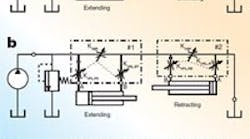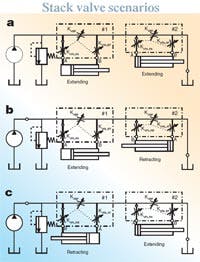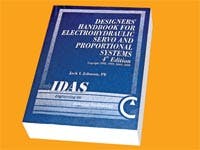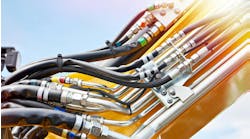The last edition of “Motion Control” dealt with drawings to help visualize valve function in different ways. Toward that end, an additional variation of the analytical schematic diagram can shed light on the vast number of combinations that can exist with the full series connected valve stack. This variation can also reveal the inter-sectional interactions that take place. These schematics are simplified diagrams that show only the essential elements for the specific combination. Three of the many combinations are shown in Figure 1.
Some background
As background, four points need to be made. First, it has been my practice and personal preference to always connect the A port of the valve to the cap end of the cylinder. This is not required, it is strictly personal and hopefully, consistent through the years.
Second, when any spool is shifted enough to route flow to a work port, only two of the four variable 3-way lands in the bridge circuit schematic (which was described last month) are active — one powered land and one return land. The other two lands are in a state of increasing overlap, and, at most, supply only a few drops of fluid as bypass leakage. They can be safely ignored in most analyses, and Figure 1 reflects this practical reality.
Third, there are four combinations of extension and retraction scenarios in a 2-section valve stack. In a 3-section stack, eight simultaneous shift combinations are possible, and with four sections, there are 16 different extend-retract combinations possible, and so on, limited in part only by the mental and manual dexterity of the machine operator. Only three of the four possible combinations are shown in Figure 1. Readers are urged to review all the possible combinations in larger valve stacks.
Fourth, because the analytical schematic portrays the 4-way valve as a series of variable orifices rather than in conventional ISO symbology, the simplified diagram of Figure 1 “flips” the cylinders around as well as the valve land nomenclature to illustrate the idea of shifting to extend versus retract. Look carefully at the schematics and the port and variable orifice labels and view them in the context of the more familiar standard ISO symbology.
Tracking flow and pressure
Figure 1, without the encumbrances of closed valve lands, clearly shows how the flow through the bypass combines with the return flow out of the load cylinder of Section #1 to form the input flow to Section #2. The amount of flow entering Section #2 largely depends on two things: the degree of shift of Spool #1 and the area ratio of Cylinder #1. If both spools are shifted to extend the cylinder, as in Figure 1a, flow entering the second section will always be equal to or less than pump flow because of the rod end area of Cylinder #1. If Spool #1 is centered, then the bypass land is fully open while all the 4-way lands are closed, and Section #2 receives full pump output flow.
It should be apparent that the full series connection is capable of pressure intensification. Imagine that a heavy load is on Cylinder #2, a light load on Cylinder #1, and both spools are shifted. In this scenario, the pressure in the connection between the two sections can be greater than pump pressure by the area ratio of Cylinder #1. This intensification is used by machine operators to motivate otherwise large loads on Cylinder #2.
But the pressure can be excessive. Suppose Cylinder #2 fully extends and stalls, Cylinder #1 is still somewhere within its normal stroke range, and Spool #1 is fully shifted. The pump will be totally blocked, and its pressure will rise to the relief valve setting. If the area ratio of Cylinder #1, for example, is 2:1, the inter-sectional pressure will be approximately twice the relief valve setting. This could be dangerous, so circuit designers must be aware of pressure intensification and properly design for it.
A different scenario
Figure 1b shows the simplified circuit when Spool #1 is shifted to extend while Spool #2 is shifted to retract. This scenario will intensify pressure, just as in Figure 1a. If the two cylinders have the same bore and rod diameter, then Cylinder #2 will retract at approximately the same speed that Cylinder #1 extends. This could be useful when trying to coordinate the two motions. However, it will not absolutely synchronize the two cylinders. Operator skill or automatic control is required to do that.
Figure 1c shows the simplified analytical schematic when Spool #1 is shifted to retract while Spool #2 is shifted to extend. This circuit will result in flow intensification for the second section. That is, the flow entering Section #2 will be greater than the pump flow. The excessive amount depends on the amount Spool #1 shifts and the area ratio of Cylinder #1. As drawn, if both cylinders have the same bore and rod diameter, their respective speeds will be approximately the same but in different directions, because one will be extending and the other retracting.
Cylinder flow regeneration can occur with the full series connected stacks. This can be seen by again looking at Figure 1a. In this scenario, suppose that Spool #1 is not fully shifted, but Spool #2 is shifted fully. The load on either cylinder is not important to the immediate discussion, but load will affect the amount of flow regeneration.
Further suppose that Cylinder #1 is somewhere about mid stroke, but Cylinder #2 reaches full stroke and stalls. The higher pressure on the cap end of Cylinder #1 will motivate it to continue extending. However, the flow emerging from the rod end combines with pump flow and results in a higher speed for Cylinder #1. Flow regeneration is taking place and flow is negative in Section #1’s bypass land. The pressures in the system will depend on the amount of spool shift in Section #1, the cylinder dimensions, and the load on Cylinder #1.
Other combinations and scenarios can be explored, but are beyond the scope of this brief discussion. Readers are encouraged to satisfy their curiosities and ponder the many “what ifs.” The message is to not limit yourself to a single drawing, but redraw as equivalent circuits and use cutaways to your advantage. There is often some point that is clearer in one but not the others.
We will expand on this discussion next month by addressing similarpoints regarding partial series connected open-center valves.
Jack L. Johnson, P. E., is an electrohydraulics specialist and president of IDAS Engineering Inc., Milwaukee. For more information, contact him at (414) 355-0152, e-mail [email protected], or visit www.idaseng.com.
Handbook contains wealth of info on servo system design
The fourth edition of the Designers’ Handbook for Electrohydraulic Servo and Proportional Systems is an expansion and improvement upon the popular third edition that some referred to as the “bible of electrohydraulic technology.”
Nowhere else can you find the wealth of methods and example problems for handling the twists and bends of plumbing and manifolds and the like, allowing better design-time control over pressure losses and the design of more efficient hydraulic circuits.
Three chapters were also added to deal with methodologies and example problem solutions for mechanical loads. These chapters show you how to reduce loads to their four essential elements, reconcile them through gears, pulleys, or whatever, and show how to solve problems with triangulated loading, cylinders, and their linkages, which are common in hydraulic applications, especially mobile equipment.
More methods were requested for control systems and modeling, so a chapter was added on how to make a completely linear analysis of a motion control servo system having an unequal area cylinder. That chapter is followed by one that shows how to include the dynamic limitations (frequency response) of the control valve in a hydraulic system. The result is a unique approach to an old problem, yet solutions are eminently practical. A new chapter has also been included on optimal sizing of hydraulic motor circuits.
Finally, three new chapter s have been added to teach you about the ever-increasing role of electronics in hydraulic control systems. There is a chapter on basics of electricity and electrical measurements; another is a veritable catalog of tutorial explanations of the common electronic devices needed in the modern electrohydraulic system, including all the popular transducers and signal conditioners. All of it is demystified for you.
Readers also wanted more on mobile equipment electronic systems, so that has been added in a special chapter. You will have answers to how batteries work their seeming magic (and what you need to do to help them), how vehicle charging systems work, and how joysticks work and interface with the rest of the electrical system.
In all, nearly 250 pages have been added, creating an indispensable reference of 784 pages. It is the musthave technical reference for anyone wanting to get on board the electrohydraulic technology juggernaut.
The book sells for $149.95, plus $5 shipping and handling from the H&P Bookstore. Visit www.hydraulicspneumatics.com and click on the Bookstore button to order. Once at the Bookstore page, scroll down to the hyperlink to download a PDF order form. Fill out the form and fax it to the number indicated.



